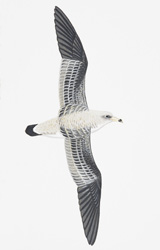Seabirds can navigate by smell
The EU-funded SOMA project set out to study the Cory's shearwater (Calonectris diomedea) to better understand how it responds to olfactory clues. The Cory's shearwater was chosen because of its widespread presence. Researchers first tested the birds' ability to find food using a substance called dimethylsulphide (DMS), which is an airborne chemical associated with food-rich areas of the ocean. They found that in both laboratory and natural conditions, the birds were attracted to the smell of DMS. In another experiment, researchers blocked the birds' sense of smell and tested whether they could return home at night. They found that the birds waited until daytime if their sense of smell was blocked, but could find their way home at night otherwise. These two experiments have highlighted the important role of smell in the daily activities of petrels and other seabirds.
Keywords
Seabirds, sense of smell, food patches, olfactory navigation, Cory's shearwater, dimethylsulphide

